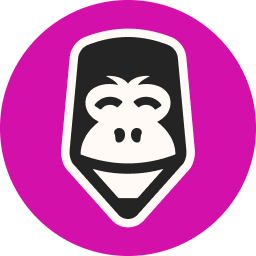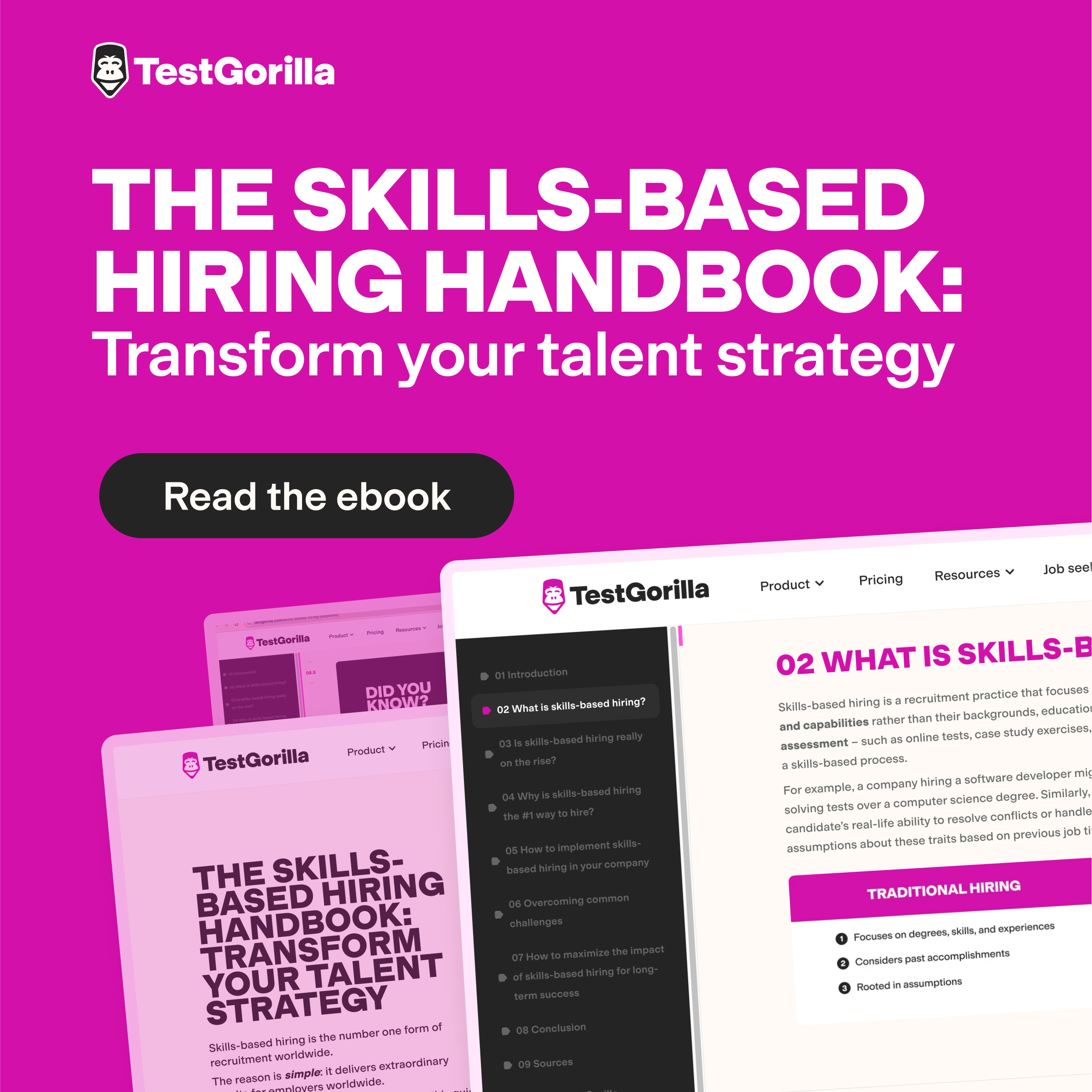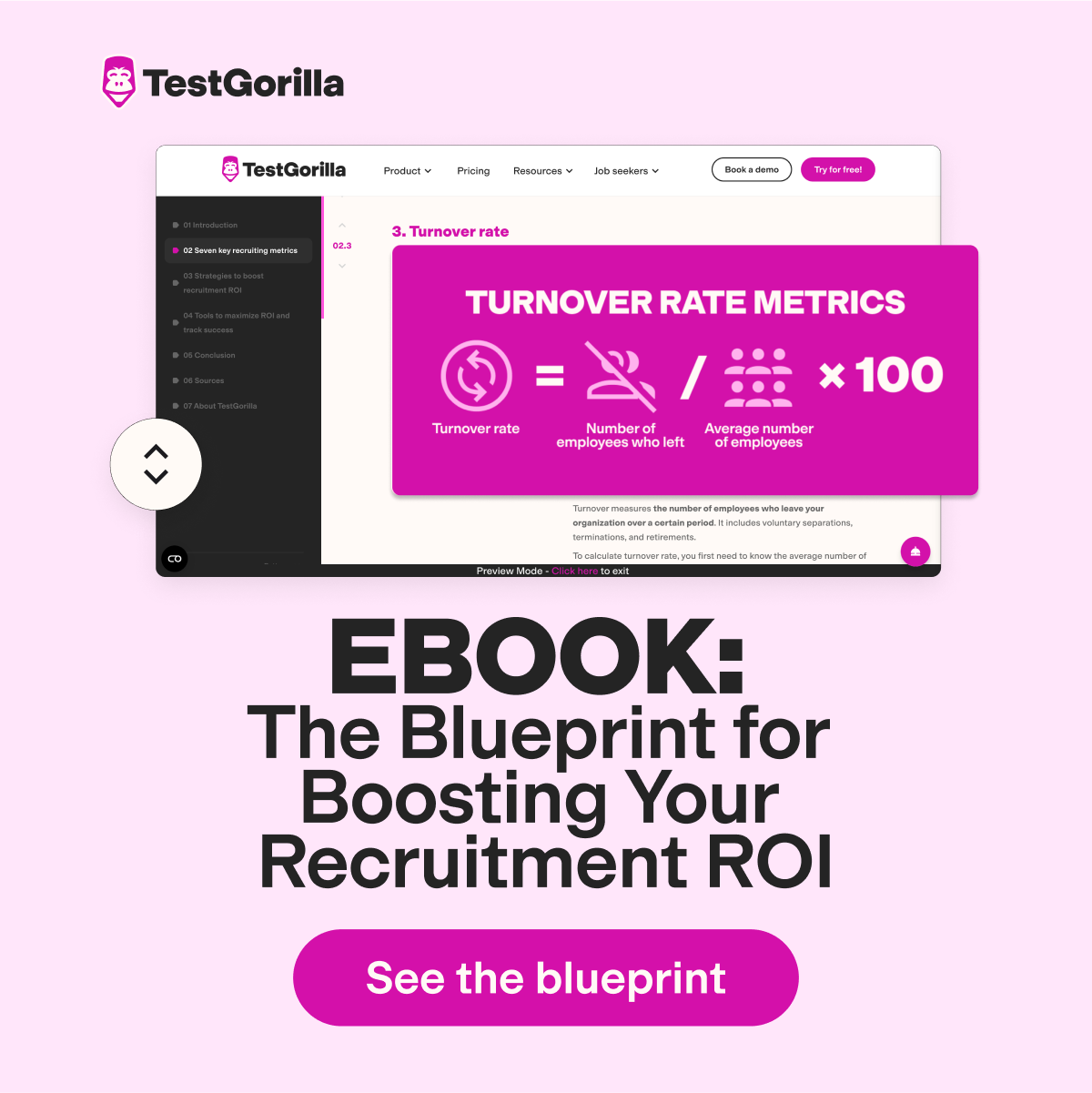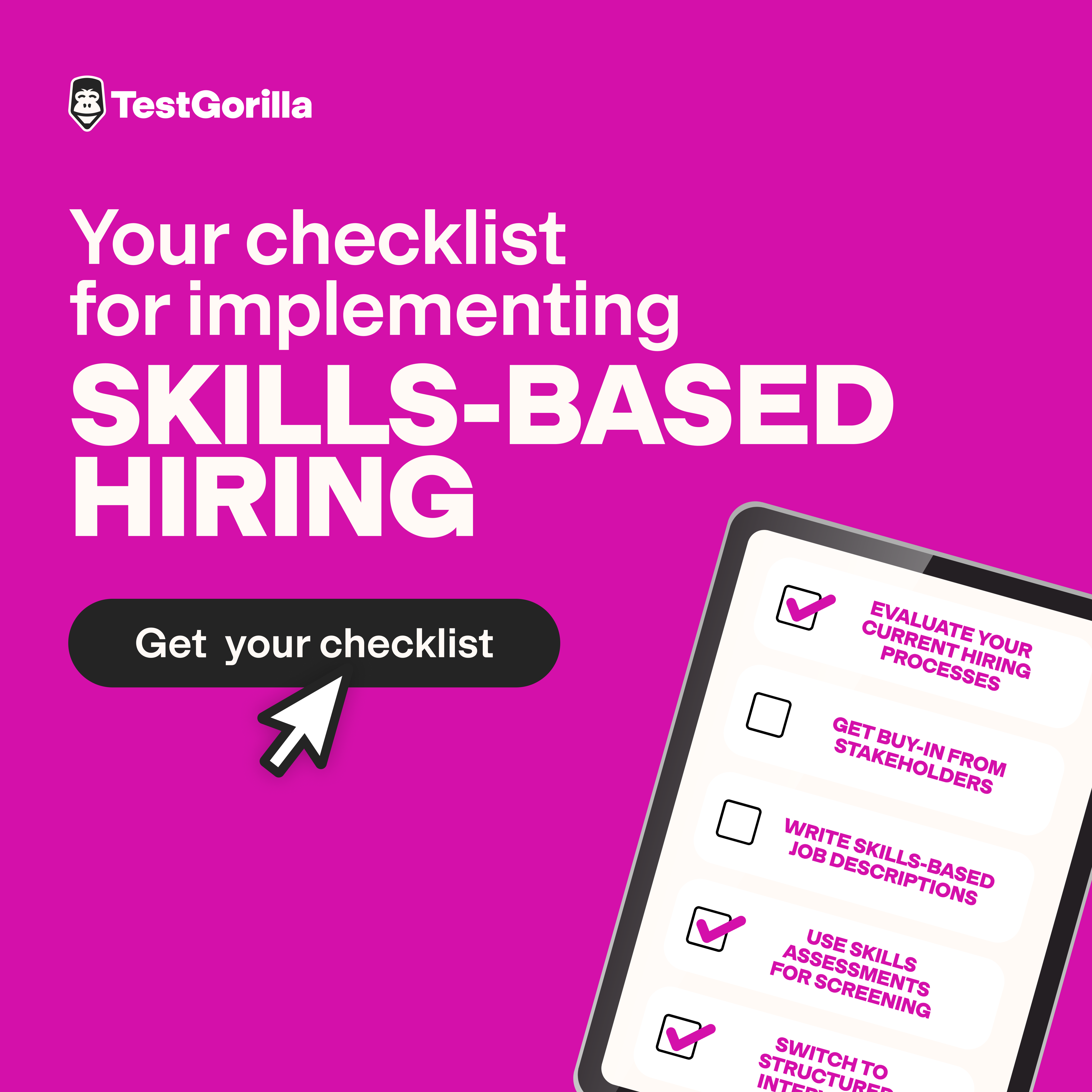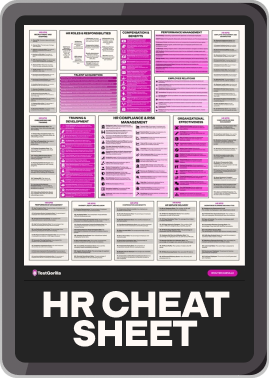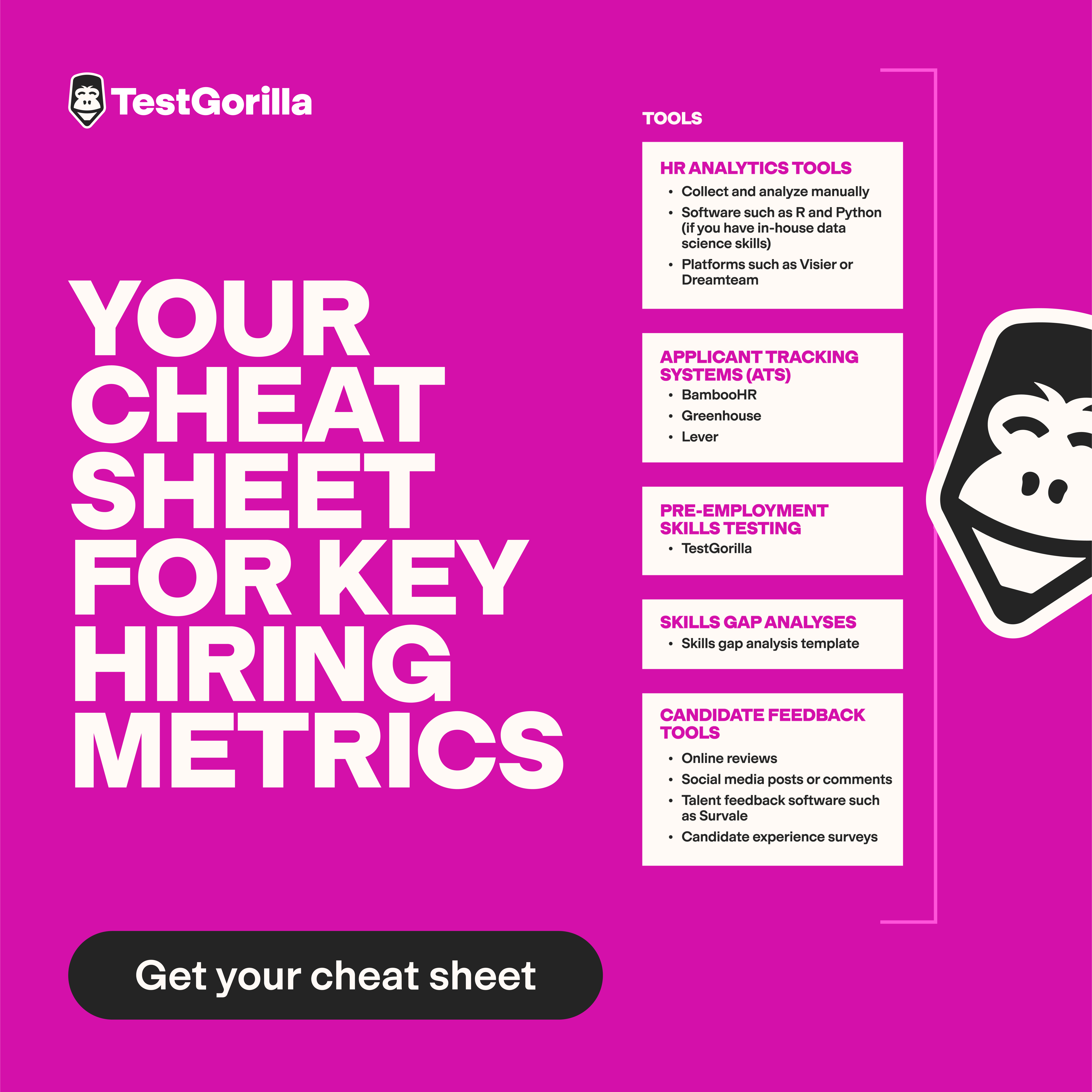56 Angular interview questions to help you hire expert programmers
Find top programming candidates with online skills testing
Do you need an easy way to hire an Angular developer for your business?
Whether you’re hiring internally, looking for freelancers, or looking to recruit your next employee, it can be difficult.
However, there’s a way to simplify the recruitment process and hire talented developers with the right Angular skills for your business.
It involves two important steps: First, use skill tests to screen your applicants. Then, conduct interviews with your best candidates to further evaluate their technical and soft skills.
The next step? Hire the perfect match.
And if you’re struggling to formulate the right interview questions to assess applicants, we have the answer.
In this article, you’ll find all the Angular interview questions you need to hire a top Angular developer.
Table of contents
- 32 Angular interview questions to ask junior developers
- 5 Angular interview questions and answers to evaluate junior developers
- 11 advanced Angular interview questions to ask senior developers
- 5 advanced Angular interview questions and answers to evaluate senior developers
- 13 Angular interview questions about processes
- 5 Angular interview questions and answers about processes to evaluate applicants
- 5 tips for using Angular interview questions to evaluate developers’ skills
- Use the right Angular interview questions to hire skilled developers
32 Angular interview questions to ask junior developers
Ask your junior developers some of these 32 Angular interview questions to assess their knowledge and determine whether they would be good additions to your team.
Explain what Angular is.
Which skills are required to use Angular?
Which soft skills do Angular developers need?
Explain the kind of data binding that Angular deploys.
Explain how Angular is different from AngularJS.
Explain what a decorator is in Angular.
Describe some benefits of using Angular.
Explain what a template is in Angular.
Explain what annotations are in Angular.
Explain what directives are in Angular.
Define AOT compilations.
Describe some benefits of using AOT compilations.
Explain what a component is in Angular.
Explain what pipes are in Angular.
Explain what the PipeTransform interface is.
Explain what Pure Pipes are.
Explain what Impure Pipes are.
Explain what an ngModule is.
Explain what Angular filters are.
What is the Angular date filter?
What is the inbuilt Angular Json filter?
What is the limitTo Angular filter?
What is the lowercase Angular filter?
Explain what view encapsulation is in Angular.
Explain what Angular controllers are.
Explain what scope means in Angular.
Explain what lifecycle hooks are in Angular.
Explain what String Interpolation means in Angular.
Explain what a Template statement is in Angular.
Name a disadvantage of using Angular.
Explain what DOM means.
How is jQuery different from Angular?
5 Angular interview questions and answers to evaluate junior developers
Assess the depth of your candidates’ responses to the following five Angular interview questions with the help of our sample answers below.
1. Which skills are required to use Angular?
Do your applicants know that HTML, CSS, JavaScript, and (of course) Angular knowledge are vital skills required to use Angular?
Are they aware that TypeScript and Angular Command Line Interface knowledge is also important, and can they show that they have the required skills to become a skilled addition to your team?
2. Which soft skills do Angular developers need?
Some of the crucial soft skills required to be a skilled Angular developer include empathy, time management, communication, and attention to detail. Teamwork is also vital for Angular developers. Do your applicants have the right soft skills to join your organization?
Find top Angular programmers the easy way
Book a free live demo with us and discover how to find top programmers with our talent assessments.
Find top Angular programmers the easy way
Book a free live demo with us and discover how to find top programmers with our talent assessments.
3. Describe some benefits of using Angular.
Applicants should know that Angular’s strength is that it enables developers to write clean code that’s easy to maintain. They should be aware that Angular provides reusable components and data binding and offers modules that make application creation smoother.
4. Explain how Angular is different from AngularJS.
Your candidates should know that while Angular uses TypeScript, AngularJS uses the JavaScript programming language. They should also know that Angular uses different components and directives, while AngularJS supports a model-view-controller (MVC) design.
Do your candidates know that Angular supports mobile browsers while AngularJS doesn’t?
5. Explain what Angular filters are.
Do your applicants know that developers use Angular filters to filter items from various items in an object array or an array?
Can they explain that the filter selects the subset of the items it takes from an array and returns the new array, displaying the item on the UI?
The best insights on HR and recruitment, delivered to your inbox.
Biweekly updates. No spam. Unsubscribe any time.
11 advanced Angular interview questions to ask senior developers
Ask your senior developers some of these advanced Angular interview questions to assess their knowledge and determine whether they have what it takes to join your organization.
Explain what a JIT compilation is.
Explain the difference between JIT and AOT compilations.
Outline what the @Component decorator does.
Explain what services do in Angular.
Explain what Promises are in Angular.
Describe what Observables are in Angular.
Explain the Reactive forms method.
Explain what Bootstrap is.
Explain what Eager loading is.
Explain what Lazy loading is.
Explain what RxJS is.
5 advanced Angular interview questions and answers to evaluate senior developers
Evaluate your candidates’ knowledge and assess their responses to the five questions below by comparing them to our sample answers.
1. Explain what a JIT compilation is.
Experienced applicants should know that JIT is short for just-in-time. A JIT compilation is a process that developers use to compile code during the execution of a program rather than before. Applicants may know that JIT is also called dynamic compilation.
2. Explain the difference between JIT and AOT compilations.
While JIT works by downloading the compiler and compiling the code before displaying the output in the browser, AOT (ahead-of-time) will have already compiled the code during the application building process.
Applicants should know that AOT loading is faster than JIT because compilation in JIT happens at runtime.
3. Explain what services do in Angular.
Can your applicants explain that services in Angular complete tasks that multiple components use? Services also complete operational tasks and ensure developers don’t have to rewrite code.
Can your applicants give examples of the tasks that Angular services complete, including image fetching and database management?
4. Explain what Promises are in Angular.
Advanced Angular developers should know that Promises handle asynchronous events and emit one value at a time. Do they know that Promises execute straightaway after creation?
Your candidates may explain that Promises differ from Observables, which handle several asynchronous events over a certain time.
5. Explain the Reactive-form method.
Can your applicants explain that the Reactive-form method is centered on data flows? Are they aware that using Reactive forms involves using the component to manage data flows directly?
Candidates should also know that Reactive forms work with code, which is different from the Template form method.
13 Angular interview questions about processes
Ask your developers some of these 13 Angular interview questions about processes to determine whether their knowledge will take your organization in the right direction.
Explain what the ngOnChanges() lifecycle hook does.
Explain what the ngOnInit() lifecycle hook does.
Explain what the ngDoCheck() lifecycle hook does.
Explain what the ngAfterContentInit() lifecycle hook does.
Explain what the ngAfterContentChecked() lifecycle hook does.
Explain what the ngAfterViewChecked() lifecycle hook does.
Explain what the ngOnDestroy lifecycle hook does.
Explain how you would use the ngFor directive in a tag.
Explain what manual bootstrapping does.
Explain what automatic bootstrapping does.
Name three Angular building blocks and explain what they do.
Explain what the digest cycle process is in Angular.
Which approach would you use to create a service in Angular?
5 Angular interview questions and answers about processes to evaluate applicants
Evaluate your applicants’ responses to the following five Angular interview questions using the answers below as a guide.
1. Explain what manual bootstrapping does.
Do your applicants know that manual bootstrapping helps developers initialize the app, giving them more control over the process? Can they explain that with this method, developers have extra flexibility to complete other operations before the page compilation process?
2. Which approach would you use to create a service in Angular?
Applicants should know that there are different ways to create a service in Angular.
Developers can specify the providedIn property by using @Injectable decorator. For instance, they can register the articleService at the root level and specify this in the code. Doing this will mean that Angular will create a single service-class instance and use this instance for any class that uses it.
Candidates may also explain that if they need to reduce the service class’s scope, developers can register it inside the @Component decorator in the provider’s property.
3. Name three Angular building blocks and explain what they do.
Three important Angular building blocks your applicants may name in response to this Angular interview question include:
Dependency injection: Developers use dependency injection to provide the new components with the required dependencies.
Services: This building block has several properties, including values, features, and functions, which contribute to the successful building of Angular applications.
Components: Components can control various views (different parts of the screen). The components feature the application logic that developers define in a class.
4. Explain how you would use the ngFor directive in a tag.
Are your applicants aware that developers use the ngFor directive to create tables and lists in HTML templates? Can they explain that developers use the directive to iterate over an object and make templates? Your applicants may explain that developers can use the following code to use the ngFor directive:
5. Explain what the digest-cycle process is in Angular.
Can your applicants explain that the digest cycle is a process where developers monitor a watchlist to track the changes that happen to a watch variable? Are they aware that developers can compare each version of the model values using each digest cycle?
5 tips for using Angular interview questions to evaluate developers’ skills
Below, you’ll find five tips on how to use these Angular interview questions to evaluate developers’ skills successfully.
1. Start by inviting applicants to complete a skills assessment
Our first tip is this: Start the recruitment process with skill testing (after applicant sourcing).
This step involves building one comprehensive skills assessment of up to five individual tests – one of which can be TestGorilla’s Angular test.
The best moment to initiate candidate skill testing is right after you’ve sourced applicants. This approach makes the hiring and decision-making processes easier and faster.
2. Inform interviewees about your Angular developer role
Here’s the second tip: At the beginning of each interview, give candidates detailed information about the role.
Build on your job description and let your interviewees know what the role involves. At the same time, you can use this opportunity to tell them more about the company’s structure and your role in it.
This way, you’re helping them gain a better understanding of their potential new work environment.
Discover the power of online pre-employment testing
Sign up for your free plan and unlock the power of skills testing.
3. Ask questions that are appropriate for your candidates’ level of experience
Our third little tip: Choose your Angular interview questions wisely.
Put yourself in your interviewees’ shoes and consider the candidate experience: If you’re using advanced-level Angular interview questions to assess junior developers or junior-level questions to assess highly experienced candidates, you’re undermining your efforts to build a strong employer brand and a positive candidate experience.
Instead, select questions that are in line with your candidates’ level of seniority to show them that you value their time, skills, and experience and to be able to assess their knowledge accurately.
4. Use a scoresheet to take notes
Here’s the fourth tip: Take notes. You won’t remember every detail from the interview.
Hiring is a collaborative effort that is based on all the data you collect; note-taking will enable you to review your candidates’ responses after you complete all interviews and make the right hiring decision.
A good option for note-taking is to use a scoresheet for a more systematic review of your candidates’ performance at the interview.
5. Hire applicants and give tactful feedback to candidates you reject
Our fifth and final tip: Let your unsuccessful candidates know you haven’t retained their application and provide feedback (based on tests and interview results) to improve the candidate experience.
At this point, all that’s left is to do is to hire and onboard the right candidate. Use the data you’ve gathered during the recruitment process to design a personalized training program and help them get up to speed faster.
Use the right Angular interview questions to hire skilled developers
Sourcing and hiring skilled developers can sometimes feel like looking for a needle in a haystack, but if you use these two simple steps, your hiring process will become much easier to manage:
Ask applicants to complete a skill assessment featuring an Angular test before screening their resumes or conducting interviews
Use the right Angular interview questions to find out whether your applicants have the necessary skills to join your team
Use our Angular interview questions, Angular dev job description template, tips, and skills tests. Sign up for a TestGorilla free plan.
You've scrolled this far
Why not try TestGorilla for free, and see what happens when you put skills first.

